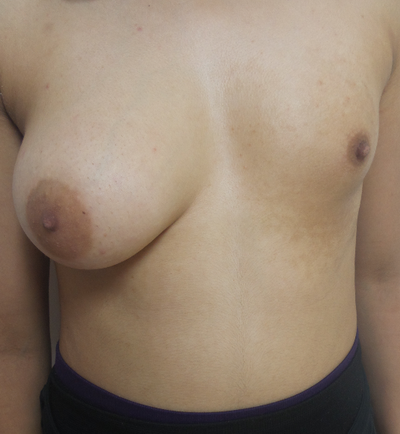|
|
Abstract
Becker's melanosis is one of the not so common nevi, which usually appears
peripubertal. Hairy or not, it seldom has extra-cutaneous manifestations,
however, it has been rarely reported to be associated with other developmental
anomalies in skin, muscles, and bones on the same side of the nevus in the
so-called "Becker's nevus syndrome".
Introduction
Becker's melanosis is a cutaneous hamartoma characterized by well circumscribed
hyperpigmented macules or patches with or without hypertrichosis. The condition
was first described by S W Becker in 1949 [1].
Becker's nevus syndrome is characterized by the presence of Becker's melanosis
associated with other developmental anomalies in skin, muscles, and bones
on the same side of the nevus [2].
Case report
A 14 years old female patient presented with unilateral left mammary
hypoplasia inspite of normal development of the contralateral one, in addition
to normal developmental and pubertal milestones, Closer examination revealed
a well circumscribed area of macular hyperpigmentation without hypertrichosis
involving part of the area of the hypoplastic breast, which was stated to
be of 3 years duration according to the patient's mother. Laboratory investigations
were done and revealed no abnormalities and all sex hormones were in normal
range and mammography and breast ultrasonography revealed hypoplastic left
breast. At this point, the diagnosis of Becker's melanosis with ipsilateral
mammary hypoplasia was concluded. Full body scan and musculoskeletal assessment
were performed and revealed no abnormalities, so we reached the diagnosis
of Becker's nevus syndrome.
Discussion
Becker's melanosis is a cutaneous hamartoma characterized by circumscribed
hyperpigmentation with hypertrichosis on shoulder, anterior chest, and scapular
region. It usually presents unilaterally [3].
The exact pathogenesis of Becker's melanosis is not known. Many authors
suggested the hypothesis of androgen hyper-responsiveness evidenced by peri-pubertal
onset, male predominance, acne and hypertrichosis within the lesion [4].
Becker's nevus syndrome is characterized by the presence of Becker's
nevus with cutaneous manifestations such as; granuloma annulare, basal cell
carcinoma, malignant melanoma, lymphangioma and developmental anomalies
such as; osteoma cutis, hypohidrosis, spina bifida, scoliosis, pectus carinatum,
congenital adrenal hyperplasia, quadriparesis, accessory scrotum[4],
breast hypoplasia [5], supernumerary nipples
[6], aplasia of the pectoralis major muscle
[7], limb reduction [8],
segmental odontomaxillary dysplasia [9],
and lipoatrophy [10].
Histopathologic examination reveals acanthotic epidermis with variable
degree of hyperkeratosis, elongation of rete ridges and increased amount
of melanin in the basal layer [11].
Treatment modalities of the hypertrichosis component include; electrolysis,
waxing, camouflage makeup and laser hair removal. Nd:YAG and Q-switched
ruby laser are reported to be successful treatment modalities of the hyperpigmented
part [12]. Spironolactone is a synthetic
mineralocorticoid. It functions as aldosterone receptor antagonist with
antiandrogen properties [13]. Spironolactone
is reported to be beneficial in treatment of mammary hypoplasia as it causes
down regulation of androgen receptors leading to improvement [14].
In our case, only Becker's nevus and ipsilateral mammary hypoplasia could
be detected of peri-pubertal onset, and based on that the patient was set
on Spironolactone 100 mg/d and is showing promising improvement in the size
of the affected breast after 2 months of therapy till now, supporting the
hypothesis of the role of the androgen hyper-responsiveness in Becker's
nevi.
References
1. Dasegowda, S.B., Basavaraj, G.B., Nischal, K.C., Swaroop,
M.R., Umashankar, N.P. and Swamy, S.S., 2014. Becker's nevus syndrome. Indian
journal of dermatology, 59(4), p.421.
2. Mehta, P., Kumar, R., Jain, S.K. and Rai, N.N., 2014.
Unilateral asymmetrical double Becker's naevus. Indian Journal of Dermatology,
Venereology, and Leprology, 80(5), p.470.
3. Moss C, Shahidullah H. Naevi and other Developmental
Defects. In: Burns T, Breathnach S, Cox N, Griffiths C, editors. Rook's
Textbook of Dermatology. 8th ed. Vol 1. Wiley-Blackwell; 2010. pp. sS18.17-18.19.
4. Person, J.R. and Longcope, C., 1984. Becker's nevus:
an androgen-mediated hyperplasia with increased androgen receptors. Journal
of the American Academy of Dermatology, 10(2), pp.235-238.
5. Jung, J.H., Kim, Y.C., Park, H.J. and Cinn, Y.W., 2003.
Becker's nevus with ipsilateral breast hypoplasia: Improvement with spironolactone.
The Journal of dermatology, 30(2), pp.154-156.
6. Urbani, C.E., 2001. Paradominant inheritance, supernumerary
nipples and Becker's nevus: once again!. European Journal of Dermatology,
11(6), pp.597-0.
7. Moore, J.A. and Schosser, R.H., 1985. Becker's melanosis
and hypoplasia of the breast and pectoralis major muscle. Pediatric dermatology,
3(1), pp.34-37.
8. COPEMAN, P.M. and JONES, E.W., 1965. Pigmented hairy
epidermal nevus (Becker). Archives of dermatology, 92(3), pp.249-251.
9. Jones, A.C. and Ford, M.J., 1999. Simultaneous occurrence
of segmental odontomaxillary dysplasia and decker's nevus. Journal of oral
and maxillofacial surgery, 57(10), pp.1251-1254.
10. Van Gerwen, H.J., Koopman, R.J., Steijlen, P.M. and
Happle, R., 1993. Becker's naevus with localized lipoatrophy and ipsilateral
breast hypoplasia. The British journal of dermatology, 129(2), pp.213-213.
11. Lapeere H, Boone B, Schepper SD, Vergaeghe E, Ongenae
E, Geel NV, et al. Hypomelanoses and Hypermelanoses. In: Wolff K, Goldsmith
LA, Katz SI, Gilchrist BA, Paller AS, Leffell DJ, editors. Fitzpatrick's
Dermatology in General Medicine. 7th ed. Philadelphia: Mc Graw Hill; 2003.
p. 639.
12. Tse, Y., Levine, V.J., McClain, S.A. and Ashinoff,
R., 1994. The Removal of Cutaneous Pigmented Lesions with the Q-switched
Ruby Laser and the Q-switched Neodymium: Yttrium-Aluminum-Garnet Laser.
The Journal of dermatologic surgery and oncology, 20(12), pp.795-800.
13. Shaw, J.C., 1991. Spironolactone in dermatologic therapy.
Journal of the American Academy of Dermatology, 24(2), pp.236-243.
14. Jung, J.H., Kim, Y.C., Park, H.J. and Cinn, Y.W., 2003.
Becker's nevus with ipsilateral breast hypoplasia: Improvement with spironolactone.
The Journal of dermatology, 30(2), pp.154-156.© 2015 Egyptian Dermatology Online Journal
|

